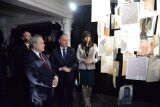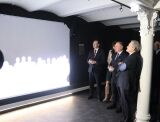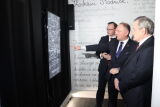back...Opening of the multimedia exhibition "Mom, why haven’t you come yet?] – letters of children from the camp on Przemysłowa Street"
“Dear parents, if you can please get me some uppers of leather shoes and put them with wooden soles size 37 and send them to me because I have nothing to walk in. (...) Send me please some grey soap and a spoon because I have nothing to eat with,"reads one of the letters written by Halinka Cubrzyńska, a former inmate of the Nazi German concentration camp for Polish children on Przemysłowa Street. This and many other letters will be on display at the first multimedia exhibition opened today, prepared by the Museum of Polish Children – victims of totalitarianism. The project was implemented thanks to funding from the Ministry of Culture and National Heritage.
The first multimedia exhibition of the Museum of Polish Children – victims of totalitarianism, titled “Mamo, czemu nie przyjeżdżasz? – listy dzieci z obozu na Przemysłowej” is based on the camp correspondence of young inmates of the Polen-Jugendverwahrlagerder Sicherheitspolizei in Litzmannstadt(a German concentration camp for Polish children that operated in Łódź from December 1942 to January 1945).
“The exhibition is intended to encourage reflection on the fate of Polish children, their suffering, loneliness and longing for family. It is also intended to encourage reflection on the essence of childhood which the young prisoners of the camp on Przemysłowa Street were ruthlessly deprived of by the Germans,” explains dr Ireneusz Piotr Maj, director of the Museum of Polish Children – victims of totalitarianism.
The opening of the exhibition is scheduled for December, because in the chronology of the German concentration camp for Polish children on Przemysłowa Street, there was a particularly tragic event in December. 80 years ago, the first transport of children to the camp took place.
The Museum, thinking primarily of the younger generation, has prepared the exhibition in multimedia form. This will allow schoolchildren to learn the story of the tragic fate of the youngest victims of the war in an accessible way.
“The nature of the exhibition marks a conscious departure from traditional narrative methods. For the most part, it makes use of multimedia techniques to evoke feelings of empathy among visitors towards the youngest victims of the Second World War through the play of light, sound and image,”adds dr Ireneusz Piotr Maj.








